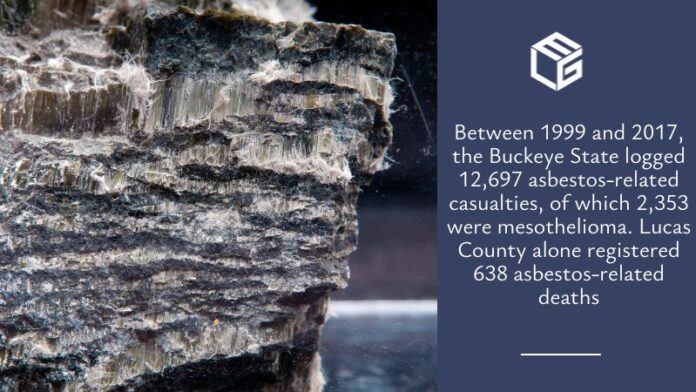The risks linked to military service are not always on the battlefield; some are disguised as innocent day-to-day occupations and are present in the materials used to build ships, barracks and bases.
Among the seemingly “innocent” is asbestos, a mineral once hailed by several industries for being affordable, durable and resistant to fire and other chemicals. Sadly, this has put thousands of exposed veterans at risk of developing a rare but deadly cancer known as mesothelioma.
Yet, the real crisis is not just the disease itself. A larger issue looms in the form of widespread misdiagnosis and delayed detection resulting from fragmented healthcare records and the absence of an effective tracking system.
A national mesothelioma registry could help end this concern, as this pushes for timely screenings, accurate findings and better recovery rates for diagnosed veterans.
Mesothelioma’s hidden toll on Ohio veterans
Mesothelioma is an uncommon disease that thrives silently but aggressively. This mainly grows in the thin layer of tissue lining certain internal organs, like the lungs, heart and abdomen. Health researchers say this is usually caused by exposure to asbestos, a mineral known for its ability to resist fire.
But the problem is that diagnosing mesothelioma is incredibly difficult. It can take decades from the initial asbestos exposure for symptoms, like chest and belly pain, nausea and unintentional weight loss to appear. And when they do, they are frequently misdiagnosed, mistaking it for other less serious conditions. Tragically, the cancer has often progressed to an advanced and complicated stage before it could be correctly diagnosed.

This situation is particularly dire in Ohio, whose military and various industries have relied heavily on asbestos for so long. Veterans who worked in shipbuilding, construction and mechanical maintenance have been especially exposed to asbestos, which increases their risk of developing mesothelioma.
Accordingly, this mineral has become a staple in numerous building products here prior to the 1980s. However, such widespread use has resulted in serious health hazards and, worse, the deaths of thousands of affected Ohioans.
In fact, data indicates that between 1999 and 2017, the Buckeye State logged 12,697 asbestos-related casualties, of which 996 were linked to asbestosis and 2,353 were mesothelioma cases.
Lucas County alone accounted for an estimated 638 asbestos-related deaths.
Even though this crisis can affect all walks of life, veterans are unfortunately among the most susceptible. Several military facilities in Ohio, like the Wright-Patterson and Youngstown Air Force bases, have been identified as critical sites of asbestos exposure.
In 2016, authorities also admitted that a facility at Toledo Express Airport in Lucas County contained harmful minerals, including asbestos. This connotes that service members, especially those who served here, are really at a higher risk of developing mesothelioma.
Recent statistics show that 30 percent of the 3,000 Americans diagnosed with such a disease each year are veterans, which highlights the urgent need for targeted healthcare and support that could help ensure that this drastically impacted population has a higher chance of survival.
Misdiagnosis, a far too frequent reality
Early detection is among the critical factors in enhancing the survival rate of mesothelioma patients. Yet misdiagnosis remains alarmingly high and common. Based on the latest data, 80.8 percent of stage 1 mesothelioma cases were confused with something else, causing the disease to worsen. Additionally, 70 percent of those in stage 2 have encountered the same issue, and the problem persisted into later stages—with 35.4 percent of stage 3 and 12.8 percent of stage 4 cases being inaccurately diagnosed.
These high misdiagnosis rates could be attributed to its nonspecific symptoms which resemble those of more usual illnesses. The rarity of mesothelioma likewise contributes to its under-recognition and delayed diagnosis. And while there may be different reasons for these misdiagnoses, one fact is certain—these incorrect findings warrant immediate attention.
The troubling incidents of misdiagnosis we see are not just plain numbers because they represent the lives that have been severely compromised just because the healthcare system falls short in detecting the disease on time. Establishing a centralized system could be a key to comprehending the complicated nature of mesothelioma.
Establishing a national registry could save lives
The prevailing issue of misdiagnosis among mesothelioma patients—particularly veterans—has been a longstanding challenge that demands comprehensive studies to improve both diagnostic methods and treatment options.
Yet, a hampering challenge is the lack of timely access to affected individuals who could contribute to this research. Mesothelioma cases can take up to two years to be included in the national statistics, which delays the researchers’ ability to reach out to their potential participants. Given the aggressive nature of the disease, many patients have already passed away before their cases are even reported, which makes it nearly impossible for them to partake in critical studies.
A national mesothelioma registry could help fight this problem by implementing an efficient case-finding system that makes patient information available whenever needed. Such a system enables researchers to quickly engage with their prospective participants and deepen their comprehension of how the disease works. This also leads to the development of more accurate disease progression models and better-informed approaches to diagnosis and treatment—thereby accelerating advancements in care and survival.
Immediate action is needed. It is high time for the Department of Defense, Department of Veterans Affairs and all healthcare partners to collaborate and prioritize the creation of a national mesothelioma registry for veterans. Such a system would reduce misdiagnosis and boost health services to ensure these individuals receive the best possible care in the face of this hostile disease.




















